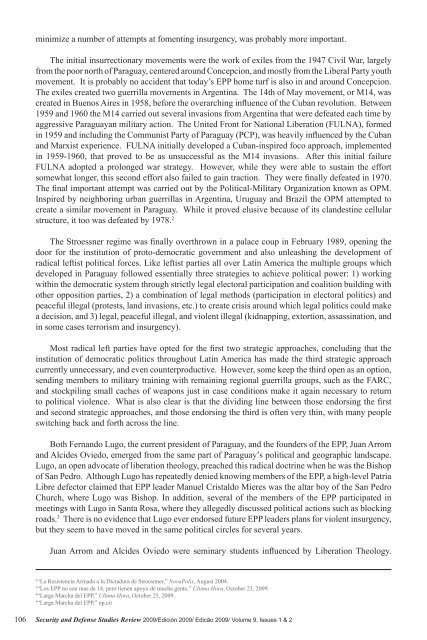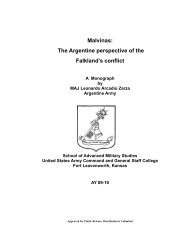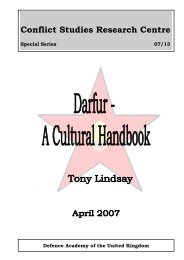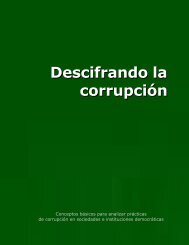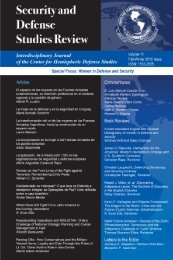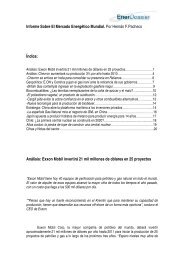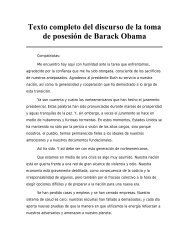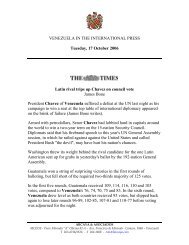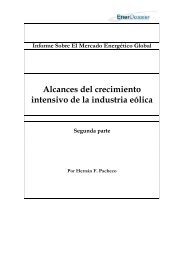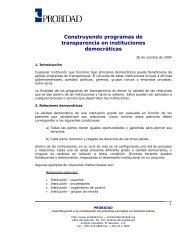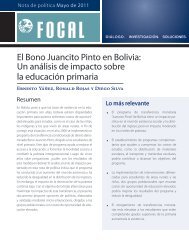minimize a number of attempts at fomenting insurgency, was probably more important.The initial insurrectionary movements were the work of exiles from the 1947 Civil War, largelyfrom the poor north of Paraguay, centered around Concepcion, <strong>and</strong> mostly from the Liberal Party youthmovement. It is probably no accident that today’s EPP home turf is also in <strong>and</strong> around Concepcion.The exiles created two guerrilla movements in Argentina. The 14th of May movement, or M14, wascreated in Buenos Aires in 1958, before the overarching influence of the Cuban revolution. Between1959 <strong>and</strong> 1960 the M14 carried out several invasions from Argentina that were defeated each time byaggressive Paraguayan military action. The United Front for National Liberation (FULNA), formedin 1959 <strong>and</strong> including the Communist Party of Paraguay (PCP), was heavily influenced by the Cuban<strong>and</strong> Marxist experience. FULNA initially developed a Cuban-inspired foco approach, implementedin 1959-1960, that proved to be as unsuccessful as the M14 invasions. After this initial failureFULNA adopted a prolonged war strategy. However, while they were able to sustain the effortsomewhat longer, this second effort also failed to gain traction. They were finally defeated in 1970.The final important attempt was carried out by the Political-Military Organization known as OPM.Inspired by neighboring urban guerrillas in Argentina, Uruguay <strong>and</strong> Brazil the OPM attempted tocreate a similar movement in Paraguay. While it proved elusive because of its cl<strong>and</strong>estine cellularstructure, it too was defeated by 1978. 2The Stroessner regime was finally overthrown in a palace coup in February 1989, opening thedoor for the institution of proto-democratic government <strong>and</strong> also unleashing the development ofradical leftist political forces. Like leftist parties all over Latin America the multiple groups whichdeveloped in Paraguay followed essentially three strategies to achieve political power: 1) workingwithin the democratic system through strictly legal electoral participation <strong>and</strong> coalition building withother opposition parties, 2) a combination of legal methods (participation in electoral politics) <strong>and</strong>peaceful illegal (protests, l<strong>and</strong> invasions, etc.) to create crisis around which legal politics could makea decision, <strong>and</strong> 3) legal, peaceful illegal, <strong>and</strong> violent illegal (kidnapping, extortion, assassination, <strong>and</strong>in some cases terrorism <strong>and</strong> insurgency).Most radical left parties have opted for the first two strategic approaches, concluding that theinstitution of democratic politics throughout Latin America has made the third strategic approachcurrently unnecessary, <strong>and</strong> even counterproductive. However, some keep the third open as an option,sending members to military training with remaining regional guerrilla groups, such as the FARC,<strong>and</strong> stockpiling small caches of weapons just in case conditions make it again necessary to returnto political violence. What is also clear is that the dividing line between those endorsing the first<strong>and</strong> second strategic approaches, <strong>and</strong> those endorsing the third is often very thin, with many peopleswitching back <strong>and</strong> forth across the line.Both Fern<strong>and</strong>o Lugo, the current president of Paraguay, <strong>and</strong> the founders of the EPP, Juan Arrom<strong>and</strong> Alcides Oviedo, emerged from the same part of Paraguay’s political <strong>and</strong> geographic l<strong>and</strong>scape.Lugo, an open advocate of liberation theology, preached this radical doctrine when he was the Bishopof San Pedro. Although Lugo has repeatedly denied knowing members of the EPP, a high-level PatriaLibre defector claimed that EPP leader Manuel Cristaldo Mieres was the altar boy of the San PedroChurch, where Lugo was Bishop. In addition, several of the members of the EPP participated inmeetings with Lugo in Santa Rosa, where they allegedly discussed political actions such as blockingroads. 3 There is no evidence that Lugo ever endorsed future EPP leaders plans for violent insurgency,but they seem to have moved in the same political circles for several years.Juan Arrom <strong>and</strong> Alcides Oviedo were seminary students influenced by Liberation Theology.2“La Resistencia Armada a la Dictadura de Stroesnner,” NovaPolis, August 2004.3“Los EPP no son mas de 14, pero tienen apoyo de mucha gente,” Ultima Hora, October 23, 2009.4“Larga Marcha del EPP,” Ultima Hora, October 25, 2009.5“Larga Marcha del EPP,” op.cit106<strong>Security</strong> <strong>and</strong> <strong>Defense</strong> <strong>Studies</strong> <strong>Review</strong> 2009/Edición 2009/ Edicão 2009/ Volume 9, Issues 1 & 2
From the very beginning, around 1990, the project they developed was to adopt the third strategicapproach <strong>and</strong> form a political movement to be known as Patria Libre with an active armed wing(not yet named) to bring about a socialist revolution. 4 Arrom is reported to have immediately begunrecruiting members for his movement, even before it was formally established. Among the earliestrecruits were many of the eight Villalba siblings. Carmen, who became Alcides Oviedo’s wife, iscurrently the EPP’s spokesperson in jail. Osvaldo Villalba is one of the EPP’s military comm<strong>and</strong>ers.Liliana Villalba was detained while taking supplies to an EPP camp back in 2006 <strong>and</strong> then released. 5Jose Villalba is not officially a member of the EPP, but was a member of the Northern PeasantOrganization (OCN), a political organization that EPP openly endorses, <strong>and</strong> now leads a group calledArticulación Urbana y Rural de Concepción (Concepcion Rural <strong>and</strong> Urban Coordination), whichcarries out political action favoring EPP causes. It has also been reported that he recruits 15- to20-year-old youths from a variety of rural movements to attend indoctrination camps <strong>and</strong> events.There, class struggle <strong>and</strong> guerrilla warfare is glorified, thus serving as a first level screener <strong>and</strong>indoctrinator for potential recruits to the EPP. 6 Monsignor Adalberto Martinez of Lugo’s formerSan Pedro diocese, said that several of the Villalbas studied in the seminary directed by Lugo in the1990s. 7In the early 1990s Patria Libre carried out its own training in guerrilla tactics in the Paraguayancountryside. They also sought professional help <strong>and</strong> sent individuals to undergo more expert trainingoutside Paraguay, apparently Chile initially, where the Manuel Rodriguez Front (FPMR), was stillactive. 8Launching a violent insurgency requires a great deal of money so it is no surprise that themovement’s first actions were aimed at acquiring funds. Their stated goal was to accumulate 40million dollars by 2003 in order to launch the revolution. A bank in Horqueta was robbed, a bankarmored car was robbed in Caaguazu, 9 <strong>and</strong> a failed attempt was made to rob a bank in Chore, SanPedro by means of digging a tunnel in December 1997. This led to the first public knowledge of theso-far unnamed armed wing <strong>and</strong> arrests of members of the inchoate group including Alcides Oviedo,Carmen Villalba, Gilberto Setrini, Francisco Lezcano, Lucio Silva <strong>and</strong> Pedro Maciel Cardozo. Acivilian court condemned the defendants to two years in prison. 10However, it seems that robbing banks was proving to be more dangerous <strong>and</strong> less profitablethan desired. It was at this time that Patria Libre probably turned to the Colombian FARC, whichresponded positively. FARC international commission member Jairo Alfonso Lesmes Bulla, akaJavier Calderon, responsible for Paraguay, Uruguay, <strong>and</strong> Argentina, <strong>and</strong> Chile, is documented astraveling to Paraguay twice, in October 1998 <strong>and</strong> in July1999. He was detained on October 2, 1998by police intelligence agents checking his travel documents but was immediately set free. In July1999, Javier Calderon returned to Paraguay, where he gave a press interview speaking about thepeace process between FARC <strong>and</strong> the government of Andres Pastrana. Throughout his travels inParaguay Calderon was always accompanied by members of Patria Libre, among them Juan Arrom. 11It was shortly thereafter that Patria Libre began carrying out kidnappings. However, this resultedin splits within the movement. Arrom <strong>and</strong> a majority of militants were willing to use the armedwing to carry out assassinations, kidnappings <strong>and</strong> other criminal activities. Others objected, <strong>and</strong>these separated from the party. 12 A first attempt at kidnapping failed against Colorado Senator ÓscarGonzález Daher. 13 In November 2001 the cl<strong>and</strong>estine organization carried out its first successful6“Mons. Zacarias cuenta evolución del EPP,” ABC Color, October 21, 2009.7Michael Warren, “Bishop-turned-president tested in Paraguay,” Associated Press, December 9, 2009.6“Vi formarse al EPP y tambien recibi entrenamiento guerrillero,” Ultima Hora, October 22, 2009.9“EPP tenia por meta recaudar US$ 40 millones para llegar al poder en 2003,” La Nacion, October 25, 2009.10“Larga Marcha del EPP,” Ultima Hora, October 25, 2009 also “EPP tenia por meta recaudar US$ 40 millones para llegar al poder en 2003,” LaNacion, October 25, 2009.11“Investigadores refuerzan hipótesis de supuesto apoyo externo al EPP,” ABC Color, December 12, 2009.12“Vi formarse al EPP y tambien recibi entrenamiento guerrillero,” Ultima Hora, October 22, 2009.<strong>Security</strong> <strong>and</strong> <strong>Defense</strong> <strong>Studies</strong> <strong>Review</strong> 2009/Edición 2009/ Edicão 2009/ Volume 9, Issues 1 & 2 107
- Page 4 and 5:
Document: Speech on “Security, In
- Page 6 and 7:
6Security and Defense Studies Revie
- Page 8 and 9:
un tema de seguridad y defensa porq
- Page 10 and 11:
Los Intereses de la República Popu
- Page 12 and 13:
En el marco estratégico descrito e
- Page 14 and 15:
Works (FAW), Geeley, Dongfeng, y Ch
- Page 16 and 17:
interés en participar en el yacimi
- Page 18 and 19:
al emplear personas locales en todo
- Page 20 and 21:
había un banco en Colombia especia
- Page 22 and 23:
ehén de los FARC, escribe de siete
- Page 24 and 25:
estadounidenses en el futuro, y por
- Page 26 and 27:
26Security and Defense Studies Revi
- Page 28 and 29:
Existe numerosa literatura que trat
- Page 30 and 31:
La Tabla 1.1, demuestra que el apor
- Page 32:
Los cuestionamiento a este modelo d
- Page 35 and 36:
….derogaremos la Ley del Cobre y
- Page 37 and 38:
Figura 4.3.Aporte de CODELCO por ve
- Page 39:
Figura 6.Elaboración propia distri
- Page 42 and 43:
de los proyectos de defensa necesit
- Page 44 and 45:
En el caso de las inversiones en de
- Page 46 and 47:
Anexo 1PROTOCOLO DE ACUERDO QUE ACO
- Page 48 and 49:
OECD. “Models of Public Budgeting
- Page 50 and 51:
proyectos nacionales y democrático
- Page 52 and 53:
DesprofesionalizaciónEn la región
- Page 54 and 55:
Según algunos autores, “no sorpr
- Page 56 and 57: (antinarcóticos), la Guardia Coste
- Page 58 and 59: supervigilen las acciones intrusiva
- Page 60 and 61: Quizás una de las fallas provenga
- Page 62 and 63: Junto con ello se elaboró una nuev
- Page 64 and 65: Colombia). Por otro, hay una serie
- Page 66 and 67: Maldonado, Carlos, “Profesionalis
- Page 68 and 69: policías y militares no ha estado
- Page 70: La relación entre fuerzas militare
- Page 73 and 74: dictaduras. En aquellos con más tr
- Page 75 and 76: efectos de planificación se ha hab
- Page 77 and 78: BibliografíaAguila, Ernesto y Mald
- Page 79 and 80: Sherman, Lawrence. et.al. 1973. Tea
- Page 81: Influenza Pandemic and its National
- Page 84 and 85: and restaurant services” is expec
- Page 86 and 87: The ability of the health sector to
- Page 88 and 89: BibliographyAlmond, D. and B. Mazum
- Page 90 and 91: El trabajo parte del supuesto de qu
- Page 92 and 93: es tanto una elección voluntaria c
- Page 94 and 95: Por otro lado, Rusia nunca ha visto
- Page 96 and 97: La Organización del Tratado del At
- Page 98 and 99: liquidez internacional pero tambié
- Page 100 and 101: petróleo recientemente descubierta
- Page 102 and 103: Dentro de este esquema, Estados Uni
- Page 104 and 105: 104Security and Defense Studies Rev
- Page 108 and 109: kidnapping, of Maria Edith de Deber
- Page 110 and 111: The political campaign that resulte
- Page 112 and 113: would carry out the more violent ta
- Page 114 and 115: of the EPP so far, is the relative
- Page 117 and 118: to accept ideas, policies or course
- Page 119 and 120: eing killed themselves—the idea t
- Page 122 and 123: In Latin America, the role played b
- Page 124 and 125: the Church to be given to the dying
- Page 126 and 127: from providing military chaplains t
- Page 128 and 129: Perhaps one of the clearest example
- Page 130 and 131: was prepared by the Office of the C
- Page 132 and 133: 132Security and Defense Studies Rev
- Page 135 and 136: Keynote Speech by Dr. Frank O. Mora
- Page 137 and 138: If successful, these infrastructure
- Page 139 and 140: Security, Intelligence and the Role
- Page 141 and 142: Clearly, security, intelligence and
- Page 143 and 144: Contratapa(Contratapa offers, in a
- Page 145 and 146: efforts have become intertwined; fo
- Page 147 and 148: comprensión de sus valores y cultu


